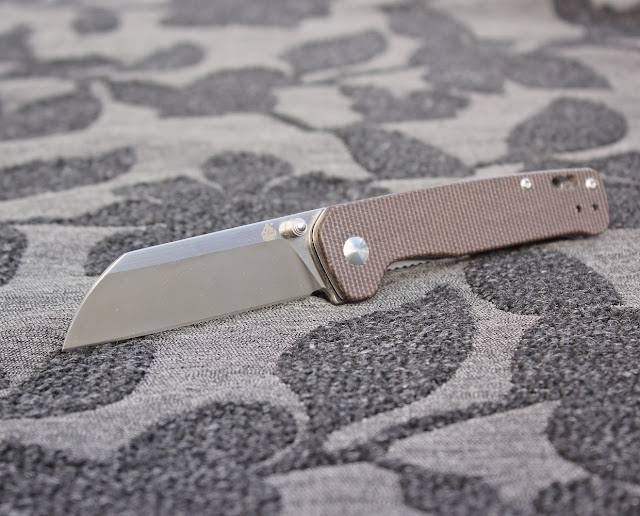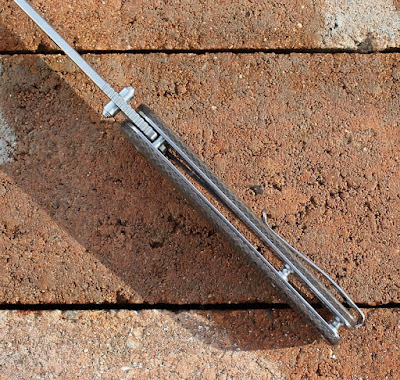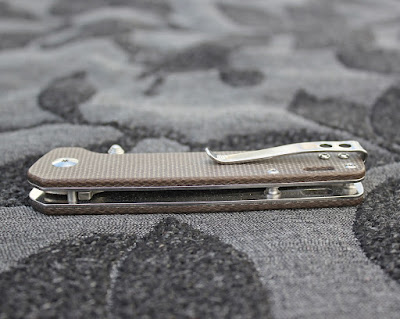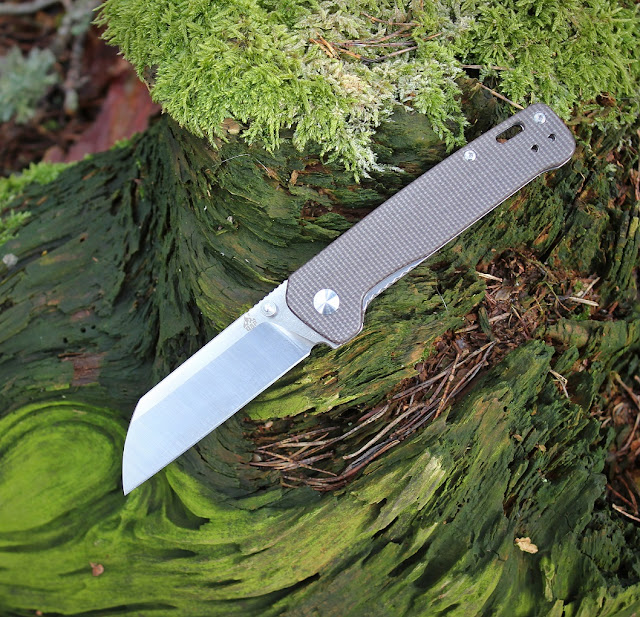- the knife that flies higher than its predecessors
Development is sympathetic. At least the times it moves in the right direction as it does for QSP Knives as a manufacturer. The impression is that they over time increased their level of quality bit by bit. Above all, it is the design that has been improved but also attention to detail. They started well but are now on another and higher level. This is noticeable with this knife, named Penguin.
QSP 130-A Penguin
I can't help but compare this to another and earlier model from QSP called Parrot. It is a cheaper knife for sure (around the 22 €-mark). The penguin costs approximately 100 SEK/10€ more where I live. When I reviewed the Parrot, I wrote that it is a really good knife and thus competing with knives such as the OKC RAT2 for instance.
Penguin doesn't. It floors both of them to put it straight! The reason is found in several choices that according to me elevates this little bird.
Penguin doesn't. It floors both of them to put it straight! The reason is found in several choices that according to me elevates this little bird.
Penguin offers budget excellence
Twitter version: All competition better watch out! QSP is turning up the heat
despite producing a Penguin
despite producing a Penguin
Blade
The blade is easily described as it is a good example of one of the basic types. It is a straightforward sheep foot blade. Nothing "modified" about it at all. This results in a straight edge that runs parallel to the spine. The spine is by the way nicely sanded. QSP has on this blade chosen not to go for a very abrupt sheep foot but opted for an angle that provides a strong but surprisingly effective tip.
The blade length is 78 mm and the height 22 mm. The finish is a well-polished two-tone satin, longitudinal on the flat part of the blade and a vertical on the bevels. The logo is one of the smallest I've seen in a long time and definitely the most discreet coming from QSP. Not much to object to. On the opposite side, you will find information about steel type in a rather unobtrusive font size.
The blade length is 78 mm and the height 22 mm. The finish is a well-polished two-tone satin, longitudinal on the flat part of the blade and a vertical on the bevels. The logo is one of the smallest I've seen in a long time and definitely the most discreet coming from QSP. Not much to object to. On the opposite side, you will find information about steel type in a rather unobtrusive font size.
A stylish sheepsfoot blade with discreet labeling
The text simply says "D2". In this incarnation, I don't mind the steel. But I always prefer stainless steels in pocket knives if I have a choice. But it must be said that this shiny finish protects the steel well from stains and so far there have been none, knock on wood.
Furthermore, it can be said that the factory edge was one of the sharpest I have experienced in a long time. Clearly in par with what for example Cold Steel usually offers, which is a high rating. Knives are sharpened anyway but how well an original edge is made gives a clue to how much the manufacturer cares about details.
Furthermore, it can be said that the factory edge was one of the sharpest I have experienced in a long time. Clearly in par with what for example Cold Steel usually offers, which is a high rating. Knives are sharpened anyway but how well an original edge is made gives a clue to how much the manufacturer cares about details.
The steel is D2 and the factory edge was really well executed
This also means that this knife cuts very well. As good as a first glance might make you believe actually. It became obvious not at least after I used it to turn an old sofa into a "folding-sofa", not fold-out. Fabric, upholstery and the layers in between had to be separated to be accommodated in a very small car on the way to the city dump, sorry, Recycle Park, as it is called nowadays.
Performing tasks like this, the similarities between such a blade shape and a Stanley knife are obvious. The tip bites well in whatever is cut and the straight edge prevents the fabric from slipping away from the edge.
Overall, this blade is very sympathetic when it comes to dealing with more mundane chores as well. You know the more common ones like cutting pieces of string, removing labels from clothing and in my case, removing plastic wrapping around cheeses.
Sometimes sheep foot blades can be so rounded that they almost lack tip, but that is not the case here as mentioned before. The Penguin handles cardboard and hard plastic too, but when the materials get thicker you do feel that this is a smaller knife. Even if the limitations are mostly due to the handle being small.
Performing tasks like this, the similarities between such a blade shape and a Stanley knife are obvious. The tip bites well in whatever is cut and the straight edge prevents the fabric from slipping away from the edge.
Overall, this blade is very sympathetic when it comes to dealing with more mundane chores as well. You know the more common ones like cutting pieces of string, removing labels from clothing and in my case, removing plastic wrapping around cheeses.
Sometimes sheep foot blades can be so rounded that they almost lack tip, but that is not the case here as mentioned before. The Penguin handles cardboard and hard plastic too, but when the materials get thicker you do feel that this is a smaller knife. Even if the limitations are mostly due to the handle being small.
Handle
Penguin offers a handle that is plain and straight forward both in design and construction. Nothing overcomplicated about it.
The basic shape is fairly straight and slightly angular but with well-rounded corners. A finger guard and a slight bulge towards the end keep the hand in place. The last detail I could have done without since my hands are so big that the "beak" makes it feel a tad crowded for all the fingers. But in return, it is so subtle that you can place your little finger over it.
The basic shape is fairly straight and slightly angular but with well-rounded corners. A finger guard and a slight bulge towards the end keep the hand in place. The last detail I could have done without since my hands are so big that the "beak" makes it feel a tad crowded for all the fingers. But in return, it is so subtle that you can place your little finger over it.
The handle material is linen Micarta
Inside you find a pretty conventional steel frame that only deviates from the common norm by not being lightened in any way. The handle is open in the back and there you find two hourglass-shaped spacers. Together with the pivot screw, they form the three fastening points that hold the knife together. The size of the rear frame screws and clip is T6 and for the pivot screw T8, which are fairly common dimensions.
The frame itself is polished and the edges of both back and bottom are well rounded. Such details are important for overall comfort. Especially if the insides of the liners are sharp they tend to press against the little finger when you cut something and the knife pivots in your hand. That is avoided here.
The frame itself is polished and the edges of both back and bottom are well rounded. Such details are important for overall comfort. Especially if the insides of the liners are sharp they tend to press against the little finger when you cut something and the knife pivots in your hand. That is avoided here.
An open construction built on a solid steel frame
Screwed to the steel-liners you find sides made of linen-Micarta. In the past, QSP has used its own version called Flax*. The color, in this case, is brown and the finish is semi-polished. It, therefore, does not provide very good traction. It is rather slippery, truth be told.
Penguin's ergonomics are good but not extraordinary. The handle is large enough for all fingers to fit even if just for a proper hammer grip.
This means that you can apply some force when cutting wood for example. When you do, however, the clip has a tendency to create a hot like this type of clip often do. On the other hand, it can hardly be felt at all when the knife is held in a saber grip with the thumb at the back of the blade. The thumb naturally falls on the jimpings there. They are just sharp enough to give a good grip without eating your fingers for breakfast. In reverse grip, used for draw cuts, Penguin is excellent.
A handle big enough to accommodate the entire hand, but barely
Penguin's ergonomics are good but not extraordinary. The handle is large enough for all fingers to fit even if just for a proper hammer grip.
This means that you can apply some force when cutting wood for example. When you do, however, the clip has a tendency to create a hot like this type of clip often do. On the other hand, it can hardly be felt at all when the knife is held in a saber grip with the thumb at the back of the blade. The thumb naturally falls on the jimpings there. They are just sharp enough to give a good grip without eating your fingers for breakfast. In reverse grip, used for draw cuts, Penguin is excellent.
Opening and Lock
Penguin opens with a pair of thumb studs. They are well-positioned and in combination with a well-tuned detent ball they make for a knife as easy to open as a flipper knife. It is possible to slow-roll the blade open too but it actually requires some thought. If you just press the thumb studs the blade will fly out. They elevate a bit from the handle sides which makes them easy to reach. If there is something negative to say, it is that they are a bit sharp.
One of the reasons for the smooth action and that the sturdy feeling is the oversized bronze bushings you find inside. Here QSP has chosen not to use cheaper nylon and also make them really big. Of course, it increases the contact area between the blade and the handle, which makes the knife laterally stronger.
One of the reasons for the smooth action and that the sturdy feeling is the oversized bronze bushings you find inside. Here QSP has chosen not to use cheaper nylon and also make them really big. Of course, it increases the contact area between the blade and the handle, which makes the knife laterally stronger.
Very effective thumb studs, though slightly on the sharp side
The Penguin uses a liner lock. Here it is well designed in such a way that the entire area of the lock bar is in contact with the blade base, while that contact does not occur too far in. Thus, there is room for some future wear. The geometry is good which is shown by keeping the blade fixed without movement in any direction and not least by the lock bar not sliding under load.
Part of that stability can be explained by the fact that the lock bar is not thinned at all. This means that the lock itself is exactly as strong as the rest of the frame. A detail that is often missed when liner locks are compared to frame locks that look stronger at first glance. As they say, a chain is no stronger than its weakest link.
Part of that stability can be explained by the fact that the lock bar is not thinned at all. This means that the lock itself is exactly as strong as the rest of the frame. A detail that is often missed when liner locks are compared to frame locks that look stronger at first glance. As they say, a chain is no stronger than its weakest link.
Liner lock in steel, simple and in this case well functioning
The lock is easy to disengage as the lock bar is very accessible and provided with some well-placed notches. Access is facilitated by the opposite side being recessed. The notches, in this case, are a must as the frame is otherwise polished and well rounded so without them, the thumb would have slipped off.
To Carry
The sides of this knife are quite smooth and the outer dimensions modest. When combined with a good clip you get very easy to carry EDC-knife. Penguin is not a heavy bird, it only weighs 91 g. A nice detail is that the stated weight is correct.
Penguin has got a deep ride clip with good tension
This could have been an excellent clip. As it is now it gets an OK or slightly above as most details are done correctly. The size is well adapted to the knife, the tension is excellent and the ramp adequate to work with most pockets' edges. It is also almost invisible in hand when cutting.
QSP has changed the way the clip is attached. Instead of the more common way, a recess in the outside of the handle side to prevent the clip from twisting, they put the recess on the inside. The clip thus attaches to the back end of the knife. By doing this, you get a cleaner and nicer side on the handle. This also means that the screws that hold the clip naturally become more recessed than otherwise. The clip is removable and can be flipped to the left side.
And here's the detail that lowers the score on the clip. Tips should NEVER point outwards
The clip is of the deep ride variety as seen in the picture above. No of the handle is visible when the knife is in the pocket. The only downside is that, like other clips of this type, it sits far back on the handle. This means that the loop itself is felt in the hand when you hold the knife in a firm grip or cutting for a longer period. However, under more normal use, this is not a problem.
Another detail that can be entered into the negative column is the tip of the clip. It points outwards. You simply don't do that! It's always negative. This means that you often hit the tip with your hand when the knife is in your pocket and you run the risk of scratching everything around you.
It's the only thing that stops me from saying that this is an excellent clip. Now it's "just" good.
Another detail that can be entered into the negative column is the tip of the clip. It points outwards. You simply don't do that! It's always negative. This means that you often hit the tip with your hand when the knife is in your pocket and you run the risk of scratching everything around you.
It's the only thing that stops me from saying that this is an excellent clip. Now it's "just" good.
To Conclude
It's been a long time since I came across such an educational example that knife making is about making good choices. This is especially true for the lower price categories where the budget is more limited. To achieve good knives in these segments, the right decision must be made as to where to put the focus. That's clearly what QSP been doing and succeeded with here.
Penguin is an excellent and well thought out EDC-knife
There are several examples of that process. The handle material is one even though it perhaps mostly is chosen for this specific model. Micarta and G10 must be considered equally good when it comes to performance. But micarta feels like a more luxurious material and that is the first thing you see.
Another choice that is a change compared to previous knives in this price range is the steel. The blade steel is D2 while the older Parrot, for example, is equipped with 440C. Many consider it an upgrade., but I'm not entirely sure I agree with that. "The jury is out" on this one as they say. But QSP has listened to what some loud voices on the internet believe, resulting in a change of steel. Luckily, the result is not bad at all.
Then there are a few details that are worth highlighting as I think they are really good steps in the right direction. One is the marking which is significantly more discreet than usual and actually really good looking in my opinion. I do not belong to those who think that all knife blades must be completely sterile to be appealing. If the branding is this small, it is more than acceptable.
A more important development is that the pivot screw has been made larger and above all the bronze bushings are larger than on the previous Parrot. It provides a sturdier knife with excellent action. The knife is exemplary in the way it opens and closes with a very smooth feeling.
Another choice that is a change compared to previous knives in this price range is the steel. The blade steel is D2 while the older Parrot, for example, is equipped with 440C. Many consider it an upgrade., but I'm not entirely sure I agree with that. "The jury is out" on this one as they say. But QSP has listened to what some loud voices on the internet believe, resulting in a change of steel. Luckily, the result is not bad at all.
Then there are a few details that are worth highlighting as I think they are really good steps in the right direction. One is the marking which is significantly more discreet than usual and actually really good looking in my opinion. I do not belong to those who think that all knife blades must be completely sterile to be appealing. If the branding is this small, it is more than acceptable.
QSP Penguin, a knife I highly recommend to anyone who appreciates a good straight edge
So, what you get in this knife is consistently high production quality. It shows in good fit and finish, well-rounded edges and corners, a centered blade and not least a really sharp and well-executed factory edge. You also get decent material in a knife that has both a really good blade and a nice handle. Besides, it's also good looking. All in all, a knife that shows how to focus on manufacturing resources to achieve something good that is still budget-friendly. Therefore I highly recommend this knife for all who like a good sheepsfoot blade.
I must say that it is impressive that a penguin can fly higher than a parrot even though it lacks the right kind of wings!
I must say that it is impressive that a penguin can fly higher than a parrot even though it lacks the right kind of wings!
Specification:
Length overall: 180 mm
Length folded: 102 mm
Weight: 91g
Blade length: 78 mm
Blade thickness: mm
Blade steel: D2
Handle: Micarta on a steel frame
Lock: Liner lock
Produced by: QSP, made in China
/ J - bird lover
* Flax is a variant of linen Micarta. I'm pretty sure it has to do with trademarks. The components are otherwise the same, i.e. some form of fiber joined with an adhesive under high pressure and heat.














Inga kommentarer:
Skicka en kommentar